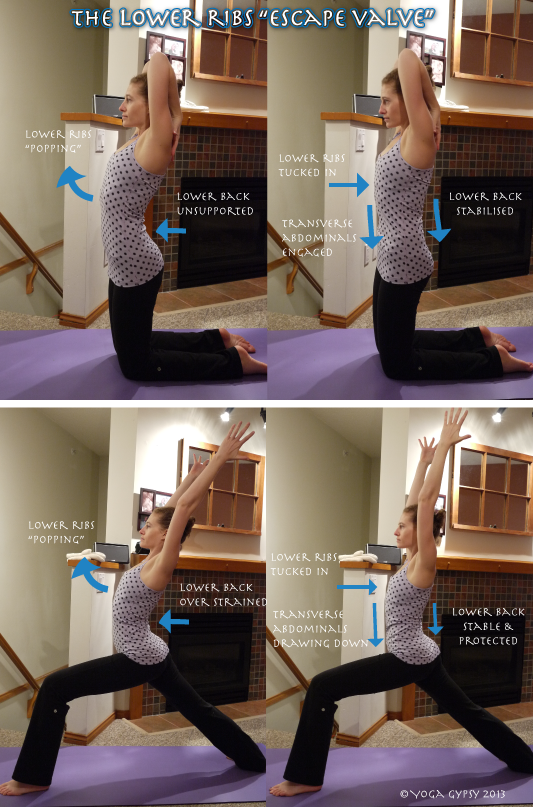Many of us, when we do yoga, "think" with the front of our bodies. So when we are asked to open the back of our bodies, we unconsciously try to manifest the instruction on the front body. In some cases this is simply because our minds aren't used to thinking about the back of the body (out of sight, out of mind!). Or we may have tightness in the back body, and so we try to compensate with the front body.
The example I want to look at today is a common one: when working to stretch the backs of our shoulders, or when moving into a backbend, we lengthen our spine, lift our collarbones, and let our lower ribs "flare" or "pop" out. It feels like we are stretching more deeply when we do this, but in fact we are using our ribs as an "escape valve" to compensate for tightness in our back body.
So, what's the big deal? Well, when this "escape valve" becomes a habit, you will carry it with you throughout your practice, including into more challenging poses like backbends. When the lower ribs are "popped", your lower back isn't being stabilised by its synergists, the transverse abdominals. This can cause excess load to be carried by the lumbar spine (the lower back), which can possibly lead to strain or injury. You want to be especially careful of this if you (like me) tend towards a "curvy" lower back in general, because it can also mean that your back is taking undue strain even in postures that are not backbends (and probably in your day-to-day life, as well).
In either case, this is really simple to correct once you're aware of it: use your abdominals to pull the lower ribs back in and down and keep them close to your body. Then go back into the pose, staying aware not to let your ribs flare out again.
Clear as mud? Have a look at the pictures!
~~~~~~~~~~~~~~~~~~~~~~~~~~~~
If you've read this far, I'd love your feedback! Was this tip helpful? Is there anything else you'd like tips about? Leave a comment!

Thank you! The pictures made me more aware of what a pose looks like, but also helped imagine what it should feel like (if that makes any sense..).
ReplyDeleteI'd love some tips on how to keep a straight leg without locking the knees in balance poses.
Hi Korakel, thanks for reading and commenting! I will definitely do a post on your question, probably in 2 weeks from now as I have another reader request lined up for next week. :) Oh, and I definitely know what you mean about FEELING a pose, which is much more important than what a pose looks like!
ReplyDeleteGreat info! I would love to learn more about backbends and this escape valve. So, do we not let the lower ribs flare in backbends? Always engage the rectus abdominus?
ReplyDeleteHi Dover. Your back and your abdominals are a pair, in particular the transverse abdominis, the deepest core muscles. In an extremely deep backbend, the rectus abdominus will be stretched, even when engaged, so the lower ribs will 'flare' to a small extent. The important thing is to keep the muscles engaged. In these extreme backbends it's actually the pelvic alignment and support from the transverse abdominis that gives us stability and the ability to come safely in and out of the poses. Hope that helped!
Delete